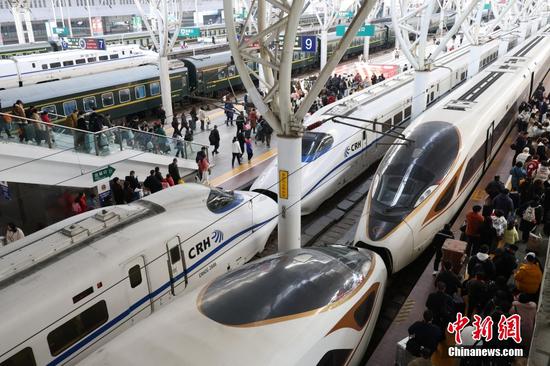Ports, trains and e-commerce depots in China's vibrant logistics links were up and running during the eight-day Chinese New Year holidays, with record work performances registered, demonstrating great supply chain resilience, even though most people in the world's second-largest economy were off work for the annual holidays.
Ningbo Zhoushan Port, one of the largest ports in China as well as the world, said in a statement sent to the Global Times on Sunday that its container throughput from February 10-17 jumped by 27 percent from the same period in 2023, in a "good start" to operations for the new year.
At the Meishan port area, which saw container throughput exceed 1 million units in January, port operators handled 196,000 standard containers during the February 10-17 period, registering a surge of 37 percent year-on-year.
In the Port of Yangshan in Shanghai, one of the largest container ports in China, the cargo peak that typically appeared before the Spring Festival holidays in previous years lasted well into the holiday week, with the port having handled a record high of 850,000 containers since January with round-the-clock work, according to a report by national broadcaster CCTV.
At Port of Lianyungang in East China's Jiangsu Province, daily cargo throughput was up 51.4 percent from the corresponding period in 2023, the Global Times learned.
Not only ports were busy. The China-Europe freight train service, the overland logistics route across Asia and Europe, also carried a record level of cargo.
A total of 91 freight trains, or 11.4 trains per day, departed Yiwu, the world's small commodity capital, for Europe during the February 10-17 period, Zhang Han, a Zhejiang transport official overseeing the development of China-Europe freight train service, told the Global Times on Sunday.
This is the 10th year that the Yiwu-Europe freight train service kept operating during the Chinese New Year holidays, and this year saw an increase of 3.6 percent from 2023, Zhang said.
In Wuhan, capital of Central China's Hubei Province, the number of China-Europe freight train arrivals and departures reached 23 during the holiday, a rise of 21.5 percent from 2023, according to the local government website on Sunday.
The trains carried new-energy vehicles (NEV), smartphones and personal computers from China to more than 160 cities across over 50 countries.
Chinese analysts said that the unsuspended logistics flow during the Spring Festival holidays, when most Chinese were off work, reflected the capability and high service awareness of China's logistics chain companies that enabled safe, stable and highly efficient international logistics channels.
The constantly improving business environment in China as demonstrated by unimpeded logistics during the holiday stands to bolster foreign trade, which faces downward pressure, they noted.
"5G wireless technology, automated operation and smart management of the supply chain were the factors that kept logistics flows unimpeded during the long holidays," Pan Helin, a professor at Zhejiang University's International Business School, told the Global Times on Sunday.
"In addition, Chinese companies' holistic approach in supply chain management and high level of service awareness were behind the smooth logistics flows during the past week," Pan said.
Amid global protectionist headwinds and weak demand, China's foreign trade grew 0.2 percent year-on-year in 2023, with new growth drivers such as NEV exports underpinning high-quality growth.
As issues such as geopolitical tensions continue to bite in 2024, global trade is facing dismal prospects. Global trade growth is expected to recover to 2.4 percent in 2024, from 0.6 percent in 2023, still well below the pre-pandemic trend of 3.2 percent, according to a UN World Economic Situation and Prospects report released on February 1.
Analysts said with supportive policies to stabilize foreign trade, the forging of new growth momentum and the exploration of new markets, Chinese foreign trade is on track to see further growth in 2024.
The CCTV report noted that the setting up of new logistics infrastructure, such as 1,800 cross-border e-commerce warehouses at overseas locations, is contributing to the resilience, smoothness and efficiency of international supply chains.


















































 京公网安备 11010202009201号
京公网安备 11010202009201号